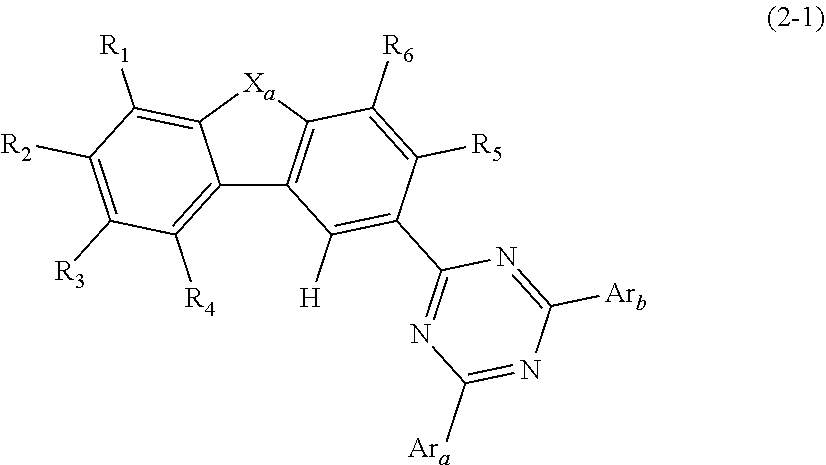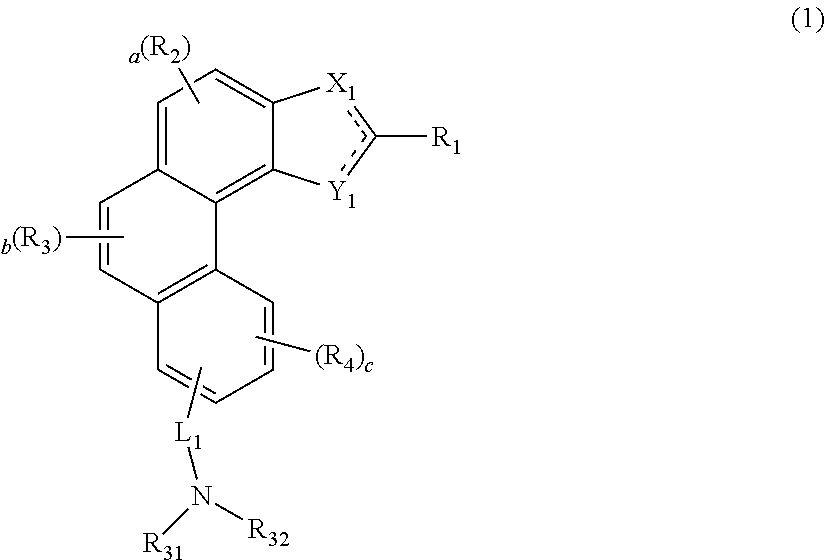Organic electroluminescent compound, a plurality of host materials, and organic electroluminescent device comprising the same
a technology of organic electroluminescent compound and host material, which is applied in the direction of luminescent composition, organic chemistry, chemistry apparatus and processes, etc., can solve the problems of unsatisfactory practical use, oled lifetime, and requirement of higher efficiency of oleds, so as to improve lifetime properties, improve luminous efficiency, and reduce the driving voltage
- Summary
- Abstract
- Description
- Claims
- Application Information
AI Technical Summary
Benefits of technology
Problems solved by technology
Method used
Image
Examples
example 1
on of Compound C-295
[0115]
[0116]Synthesis of Compound 1-1
[0117]2-bromo-7-chlorodibenzo[b,d]furan (10 g, 35.17 mmol), (4,4,4′,4′,5,5,5′,5′-octamethyl-2,2′-bi(1,3,2-dioxaborolane) (14 g, 53.5 mmol), PdCl2(PPh3)2 (2.5 g, 3.57 mmol), and KOAc (8.78 g, 89.25 mmol) were dissolved in 180 mL of 1,4-dioxane in a flask, and the mixture was refluxed at 150° C. for 2 hours. After completion of the reaction, an organic layer was extracted with ethyl acetate, and the residual moisture was removed using magnesium sulfate. The residue was dried, and separated by column chromatography to obtain 9 g of compound 1-1 (yield: 76.8%).
[0118]Synthesis of Compound 1-2
[0119]Compound 1-1 (9 g, 27.4 mmol), 2-chloro-4(naphthalen-2-yl)-8-phenyl-1,3,5-triazine (9.6 g, 30 mmol), K2CO3 (9.46 g, 68.5 mmol), and Pd(PPh3)4 (1.58 g, 1.37 mmol) were dissolved in 137 mL of toluene, 68.5 mL of ethanol, and 68.5 mL of water in a flask, and the mixture was refluxed at 140° C. for 12 hours. After completion of the reaction, ...
example 2
on of Compound C-304
[0122]
[0123]Compound 1-2 (5 g, 10.3 mmol), (naphthalen-2-yl)-boronic acid (2.13 g, 12.4 mmol), Pd2(dba)3 (417 mg, 0.515 mmol), S-Phos (423 mg, 1.03 mmol), and NaOtBu (2.5 g, 25.75 mmol) were dissolved in 50 mL of xylene in a flask, and the mixture was refluxed at 160° C. for 2 hours. After completion of the reaction, an organic layer was extracted with ethyl acetate, and the residual moisture was removed using magnesium sulfate. The residue was dried, and separated by column chromatography to obtain 1.1 g of compound C-304 (yield: 18.6%).
MWM.P.C-304575.2239.5° C.
example 3
on of Compound C-296
[0124]
[0125]Synthesis of Compound 3-1
[0126]8-bromo-1-chlorodibenzo[b,d]furan (10 g, 35.17 mmol), (4,4,4′,4′,5,5,5′,5′-octamethyl-2,2′-bi(1,3,2-dioxaborolane) (14 g, 53.5 mmol), PdCl2(PPh3)2 (2.5 g, 3.57 mmol), and KOAc (8.78 g, 89.25 mmol) were dissolved in 180 mL of 1,4-dioxane in a flask, and the mixture was refluxed at 150° C. for 4 hours. After completion of the reaction, an organic layer was extracted with ethyl acetate, and the residual moisture was removed using magnesium sulfate. The residue was dried, and separated by column chromatography to obtain 9.2 g of compound 3-1 (yield: 78.5%).
[0127]Synthesis of Compound 3-2
[0128]Compound 3-1 (9.2 g, 28 mmol), 2-chloro-4(naphthalen-2-yl)-6-phenyl-1,3,5-triazine (10.2 g, 32.2 mmol), K2CO3 (9.67 g, 70 mmol), and Pd(PPh3)4 (1.61 g, 1.4 mmol) were dissolved in 140 mL of toluene, 70 mL of ethanol, and 70 mL of water in a flask, and the mixture was refluxed at 140° C. for 4 hours. After completion of the reaction, an ...
PUM
| Property | Measurement | Unit |
|---|---|---|
| thickness | aaaaa | aaaaa |
| thickness | aaaaa | aaaaa |
| thickness | aaaaa | aaaaa |
Abstract
Description
Claims
Application Information
 Login to View More
Login to View More - R&D
- Intellectual Property
- Life Sciences
- Materials
- Tech Scout
- Unparalleled Data Quality
- Higher Quality Content
- 60% Fewer Hallucinations
Browse by: Latest US Patents, China's latest patents, Technical Efficacy Thesaurus, Application Domain, Technology Topic, Popular Technical Reports.
© 2025 PatSnap. All rights reserved.Legal|Privacy policy|Modern Slavery Act Transparency Statement|Sitemap|About US| Contact US: help@patsnap.com



